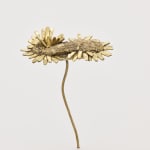Nona Inescu
7 1/8 x 4 in.
Further images
Nona Inescu’s series of sculptures, Common Daisy (Bellis perennis) draws from the Gaia hypothesis and the hypothetical world model developed by James Lovelock and Andrew Watson, Inescu explores the symbiotic relationships that exist between humans and nature. The sculptures, based on malformed specimens of daisies found in radioactive regions like Fukushima and Chernobyl, are cast in brass. This juxtaposition between the organic form of the daisy and the cold, metallic material emphasises the hybridity characterising the relationship between nature and humans.
Each daisy sculpture appears mutated, its petals and stems distorted as though shaped by external forces, such as radiation or chemical exposure. These deformities hint at the fragility of natural systems, but also their capacity of adaptation. The toxic interaction suggests the potential for the generation of unexpected life forms, an ode to hybridation. Arranged across the gallery floor, these cast daisies seem to invade the space, mirroring the pervasive nature of pollution in ecosystems. Inescu’s represents the dissolution of the boundaries between the human and the natural world, reflecting on how we navigate our symbiotic entangled ecosystems.








